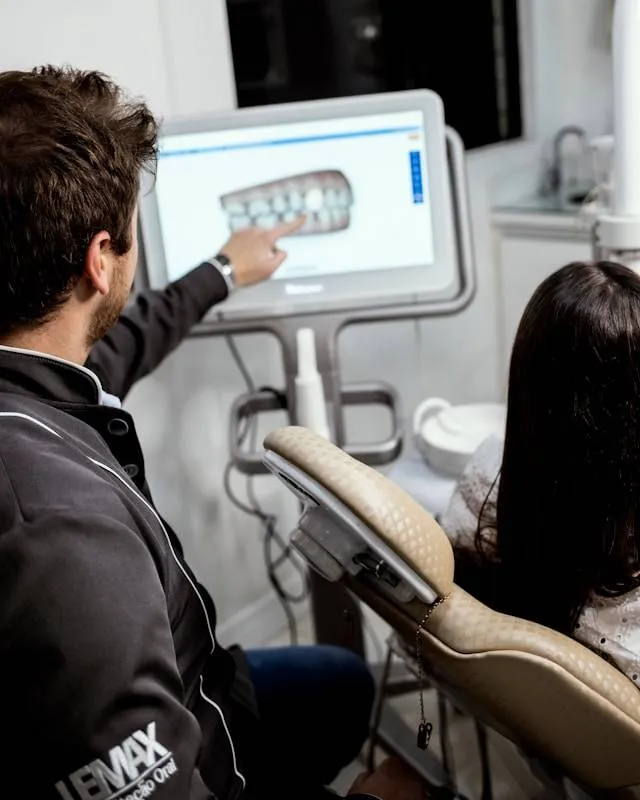2. What are the causes of temporomandibular joint inflammation?
The temporomandibular joint is like a hinge that connects your skull to your jawbone. It is one of the most complex joints in the body, controlling all the movements of your jaw. TMJ pain is a disorder that can make eating, talking, and sleeping difficult. But what causes TMJ arthritis?
2.1. Due to trauma. Temporomandibular joint inflammation can be caused by a strong impact directly to the jaw or temporomandibular joint, such as a fall, car accident, or other incident involving the jaw.
2.2. Arthritis. Temporomandibular joint inflammation can also be caused by osteoarthritis.
2.3. Bruxism. The pressure and stress caused by grinding or clenching your teeth too hard can cause TMJ pain.
2.4. Misaligned teeth or jaws. This misalignment can be caused by genetics, trauma, or improper orthodontics.
2.5. Stress. Mental or emotional stress can cause temporomandibular joint inflammation due to tension in the facial and jaw muscles. Pain can persist if the stress is chronic.
2.6. Neck and upper back posture. Neck tension, upper back muscle problems, and jaw muscle dysfunction can cause TMJ pain.
2.7. Diseases. Gout, fibromyalgia, and infections can cause temporomandibular joint inflammation.
2.8. Other factors include excessive gum chewing, dental surgery, improper orthodontic braces.
Remember, early treatment improves outcomes. Don't ignore TMJ. Getting professional help from Sakura Dental will keep your jaw healthy and functioning properly.
3. How is temporomandibular joint pain diagnosed?
Because of the wide range of causes and symptoms, TMJ can be difficult to diagnose. The main diagnostic factors are medical history, physical examination, and imaging tests.
3.1. Medical history: Diagnosis of temporomandibular joint arthritis begins with a thorough medical history. Your doctor at Sakura will ask you about your symptoms, onset, and triggers, as well as about jaw injuries, dental procedures, or chronic diseases that may cause temporomandibular joint arthritis.
3.2. Clinical examination: After reviewing your medical history, your jaw will be examined. Your doctor will palpate the joints and surrounding muscles to see if you have any pain or discomfort. Your doctor will also check your bite, facial muscle function, and jaw range of motion.
3.3. Your doctor may recommend imaging tests based on your physical exam. These tests can examine the structure of your jaw and identify abnormalities. Imaging tests that may be performed include:
- Dental X-rays to detect dental problems that may cause temporomandibular joint inflammation.
- CT scan . This scan will show details of the jaw bones and can detect abnormalities or damage.
- MRI. MRI can show details of the jaw joint and jaw muscles, helping to detect inflammation and structural problems.
- Occasionally, arthroscopy is used. A thin tube is inserted into the jaw joint so the doctor can see. This procedure is usually used after the above diagnoses are inconclusive.
4. How to treat temporomandibular joint inflammation?
Although temporomandibular joint inflammation can be serious, it is usually not life-threatening and can be treated noninvasively. Treatment depends on the severity and cause.
4.1. Home treatment and lifestyle changes
Doctors often start with home remedies and lifestyle changes. Eat soft foods, avoid excessive jaw movements such as yawning, singing loudly, and chewing gum; learn stress-reduction techniques, do relaxation exercises and gentle jaw stretches, use hot packs, and take over-the-counter pain relievers.
4.2. Physical therapy
Ultrasound, heat, and ice may be used along with exercises to strengthen and increase the flexibility of the jaw muscles.
4.3. Medicines
Your doctor may prescribe pain relievers, muscle relaxants, or anti-inflammatory medications if you have severe pain. Patients with TMJ may also be given antidepressants or anti-anxiety medications to control stress and anxiety.
4.4 Chewing trough
Temporomandibular joint disease can also be treated with a dental appliance. The appliance is custom-made for each patient and is worn over the teeth to help reduce teeth grinding and align the jaw.
4.5. Surgery
In severe cases and when other treatments are unsuccessful, your doctor may recommend surgery. Arthrocentesis, injections, or temporomandibular joint arthroscopy may be used.
4.6. Other treatment techniques
A comprehensive TMJ treatment plan may also include acupuncture, biofeedback, relaxation techniques, and various other alternative or complementary medicines.
Remember that every patient is different, so the best treatment for you depends on your specific condition and needs. With proper treatment, you can return to a normal life.
5. What are the complications of temporomandibular joint pain?
The temporomandibular joint connects your jawbone to your skull like a hinge. Temporomandibular joint inflammation is discomfort in this joint and jaw muscles. It can be caused by jaw injury, arthritis, teeth grinding, stress, or genetics.
Untreated temporomandibular joint arthritis can cause complications like any other health condition. Let's explore the complications of this condition.
5.1. Chronic pain. Chronic pain is one of the most obvious effects of untreated TMJ. The pain can radiate to the jaw, face, neck, shoulders, and back. Chronic pain can make eating, speaking, and sleeping difficult. It can reduce productivity and quality of life.
5.2. Locked jaw. Chronic temporomandibular joint inflammation can cause the jaw to lock, making it difficult to open and close the mouth.
5.3. Hearing problems. TMJ can cause hearing problems because your jaw joint is located near your ear canal. Ringing in the ears, earaches, and hearing loss can occur.
5.4. Dental problems. Temporomandibular joint pain can cause teeth grinding, which can cause wear, fractures, sensitivity, and tooth loss over time.
5.5. Difficulty sleeping. TMJ can cause chronic pain that makes it difficult to sleep. Lack of sleep can lead to fatigue, irritability, depression, anxiety, and a weakened immune system.
5.6. Malnutrition. In severe cases, TMJ can cause malnutrition by making eating painful. Not getting enough nutrients can weaken your immune system, slow wound healing, and increase your risk of infection.
5.7. Mental health effects. Chronic pain and complications of TMJ can affect your mental and psychological health. It can cause anxiety, depression, and social problems.
6. How to avoid temporomandibular joint inflammation?
Here are some ways to prevent temporomandibular joint inflammation.
6.1. Avoid overusing your jaw. Overusing your jaw can cause TMJ. Avoid shouting, singing too loudly, and yawning too widely. Try to avoid tough, hard foods that require too much jaw movement.
6.2. Pay attention to your posture. Posture is important, poor posture can cause TMJ. Maintain good posture when working at a desk or using electronic devices. Your back, shoulders and head should be straight and not leaning too far forward.
6.3. Hot or cold compresses. Applying a hot or cold compress to your jaw can help relax the muscles and relieve pain. Cold compresses can reduce inflammation by numbing and reducing swelling.
6.4. Stress management. Stress can cause TMJ due to tension in the jaw muscles. Practice meditation, yoga or deep breathing to reduce stress.
6.5. Pain relievers. Use pain relievers. Ibuprofen and other over-the-counter pain relievers can temporarily relieve TMJ pain.
6.6. Exercise. Regular exercise helps reduce stress, improve mood and maintain muscle tone, including jaw muscles.
6.7. Wear a night guard. Your dentist may recommend a night guard if you grind your teeth. This mouthpiece worn while sleeping can reduce jaw pain caused by grinding.
6.8. Physical therapy. Physical therapy exercises can strengthen jaw muscles, increase flexibility, and improve jaw alignment.
6.9. Alternative therapies. Alternative therapies such as acupuncture, biofeedback, and massage may help relieve TMJ pain.
6.10. Regular dental checkups. Regular dental checkups can help detect TMJ problems early. Your dentist can catch teeth grinding and misalignment and treat them before they cause temporomandibular joint inflammation.
Remember to consult your doctor before starting any TMJ treatment. Your doctor at Sakura will assess your condition and recommend the best treatment for you.
TMJ can be debilitating, but there are ways to prevent and treat it. Sakura will work with you to help you relieve your discomfort and improve your quality of life, from lifestyle changes and home care to professional treatments.




